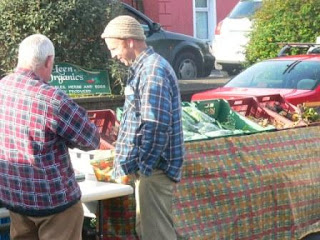
Pic: Jason Horner, organic veg seller at Ennis Farmers' Market
The UK's largest organic certification body, the Soil Association (SA), has just published a report on the market for organics. The news is mixed for the overall organic sector, and in some ways, bad for the UK organic farmer.
The situation in Ireland is different to the UK, with the market here remaining stronger. However the UK remains an export location for Irish organic produce. Along with the market itself suffering, the euro sterling differential is compounding the difficulties for Irish organic exports to the UK.
The UK organic market is worth over �2.1 billion annually. Diary is the biggest organic category (29.5%) followed closely by fresh fruit and vegetables (26.2%).
Growth in 2008 in the SA report was at 1.8%. This represented growth in three quarters, and decline in the final 08 quarter. Compared to 11% growth in Ireland in January 2009, the difference in the figures is significant.
The fairly neutral finding of a 1.8% increase disguises the fact that different categories showed sharper variations.
Sales of organic milk, cheese, meat and poultry grew by 10.6%, 11.5%, 13.3% and 17.7% in 2008. Convenience foods and confectionery fell, by 5.9% and 21% respectively. In part this reflects both cutting back and 'back to basics': sales of organic cooking ingredients were up a considerable 13.5%.
The two biggest growth areas for organic in the UK offer little opportunities for Irish farmers.
Certified organic textiles hit the �100 million mark, with organic cotton sales increasing by a full 40%. The organic health and beauty category rose by 69%. This was, however, partly due to consolidation of the certification and labelling regulations as much as an increase in sales: i.e. consumers were buying what they considered to be organic products previously anyway.
There are more signals of changes in what people eat. As reported by Ray Ryan last week for food in general in Ireland, cheaper cuts of meat are also in for organic in the UK. Worryingly, both fruit and vegetables sales were down. Some consumers are also switching to canned or frozen organic vegetables in place of fresh.
The location of purchase has also changed. This reflects both price and other considerations. ASDA, who spoke about their organic sales growth at a conference in Waterford last year, report growth of 25%. ASDA thus increased its share of the market from 8% to around 10%. Another low price multiple retailer, Morrisons, also reported growth in organic sales.
This reflects both increased organic purchasing by a broader socio-economic range of people and people from higher socio-economic groups changing where they shop.
Supermarkets that traditionally attract wealthier consumers have suffered: Tesco, Waitrose, Marks and Spencers and Sainsburys all reported losses in their organic sales.
In the analysis of the report, the SA point out that organic fruit and vegetables, Tescos largest organic area, have begun to pick up again in their stores.
The Co-op achieved double-digit percentage growth, increasing sales by 15%. This is a slightly unusual retail outlet in the UK. It is a consumer co-op with over 2200 stores, and recently took over the Somerfield supermarket chain.
While non multiple outlets (health food stores, box schemes etc) only reported 1.4% growth, farmers' markets were the exception. Growth in this route in the UK was high, at 18.6% to �23.7 million.
All told, for non multiple retailers, Around �11 million is now spent on organic products through independent retailers every week, or �568 million. This compares to �1.54 million through the multiples.
The report also calls for an improvement in the way the organic movement coveys its messages: a perhaps unexpected example of an underreported fact is the following: organic fruit and veg from box schemes are consistently cheaper than those in supermarkets.
In many ways, the strongest signal from this report from an Irish organic farming perspective point to the need for new markets in mainland Europe. In many EU countries the market remains strong or indeed continues to grow.
To access the report, click here
No comments:
Post a Comment